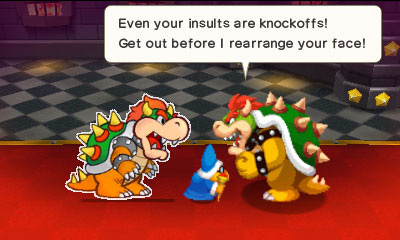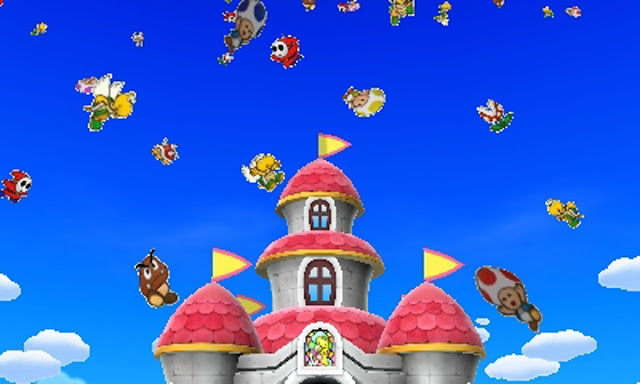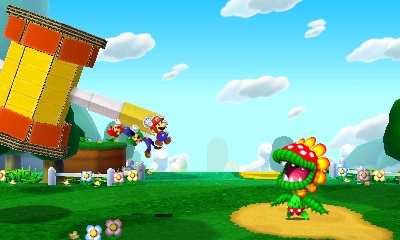Mario & Luigi: Paper Jam went so very close to irritating me. As much as I enjoy the RPG spin-off series that makes unlikely good use of Nintendo’s two platforming superstars, I have become increasingly frustrated with the company’s persistence that Princess Peach should be a damsel in distress in every game that features Mario, and is, ultimately nothing more than a prize in exchange for being a hero.
Related reading: Catch Matt’s review of this game’s predecessor, Dream Team, here.
We should be well past that kind of nonsense plot hook by now. Even if feminist critique of that particular trope wasn’t completely justifiable (though it is), the banality of the plot hook is simply boring as hell. And while it matters less for a platformer as narrative isn’t a focus (well, always. There are some platformers that tell incredible stories), for an RPG such as Paper Jam, where narrative is central to the experience, banal, bland, nonsense clichés are never a good idea.
Paper Jam could have been an opportunity to remedy this in a very straightforward manner were the developers to simply cast Peach as a hero. On a mechanical level, this particular game introduces a third character to go on the adventure with Mario and Luigi, so for the first time for the series the cast is expanded beyond the dynamic duo. That third character could have easily been Peach. Bowser could have had a different motivation for being the giant pain in the backside for a change. But no, in this game’s narrative, the worlds of 3D Mario and Paper Mario become merged, and this means that Paper Bowser and “real” Bowser conspire to capture Peach (and Paper Peach), and instead, the third hero to join Mario and Luigi is… Paper Mario. Rather than give Peach a leading role, this game literally give Mario the role twice over.
The opening plot hooks left a sour taste in my mouth that washed away quickly enough when it started to make it clear just how self aware the game is. The captured Peach and Paper Peach have conversations that could only be described as Beckettian in nature. Like Vladimir and Estragon in Waiting for Godot, there is an inherent awareness within the narrative about how absurdist it is for these characters to simply wait around to be rescued. They don’t share a lot of screen time, but their interludes while waiting for Mario and Luigi to rescue them have that same deadpan absurdist humour that is subtly subversive, as though the development team at AlphaDream realise how trite the plot hook has become but are hamstrung by some kind of mandate that Peach must be the cake at the end of the journey.
Meanwhile, over in Mario and Luigi’s quest, there are occasions in which the fourth wall is broken down completely, and it’s always quite funny when a narrative does that well. From the little sprite helper spelling out in excruciating detail what the team needs to do next (while looking out of the screen the whole time), to the constant reminders on how useless Luigi is, players are constantly being invited to place themselves within the narrative as the only ones with agency. The fusion between the “real” world and the papercraft world also allows for some surreal environments and solutions to problems to be devised. Again played heavily for laughs, the papercraft elements help to reinforce the game’s basic mandate that there be no rules about what actually goes on within it.
From there the narrative only shows itself to be more and more self aware as it goes on. Played up for maximum comedy value, there aren’t too many incidences where the development team miss the opportunity to play with expectations, poking gentle fun at the “rescue the princess” plot hook, and even Nintendo itself in places. The Mario RPG series has always been satirical, but I would suggest that with this game the satire has found a deeper purpose beyond the laughs that elevates it beyond most other comedic games.
I would still have liked a playable Princess Peach though. A bit like I would love for a Zelda game to have Zelda as the playable character; I like games with female protagonists.
The game itself plays out as we’ve seen before in Mario RPGs, and there is, in fact, a lot of stuff that has been brought over directly from Dream Team, the immediate predecessor to this one. It is again a turn-based RPG that is heavy on the in-battle mini games, and those mini games are often copied immediately across from the predecessor. Mario, Luigi, and Paper Mario each have a unique set of special abilities that have the potential to do a great deal of damage, but each of these requires players to first play out a short minigame. One has Mario and Luigi take turns kicking a Koopa shell at enemies, requiring precise timing from the player to keep the shell in motion. Another sticks all the enemies on the wall of a squash court as the three heroes take turns whacking a ball at them. And so on and so forth; there are a lot of them, and half the fun is in trying one out for the first time.
These minigames are unlocked periodically through the adventure, and each has a brief learning curve in order to be able inflict maximum damage through them. They tend to make battles draw on for quite a long time – they certainly take longer to play out then most other RPG’s special attacks – but the interactivity of them makes them highly engaging and active in nature. Coupled with the charming presentation I never once dreaded an upcoming fight. The strengths and weaknesses of enemies are also varied enough to make each new encounter a learning experience.
Each enemy has its own unique attack patterns, and by timing a defensive manoeuvre well, Mario, Paper Mario or Luigi are able to avoid damage entirely, and even inflict some back on the enemy. In boss battles this becomes critical, with bosses capable of dealing out some very significant damage. I found myself frequently needing to replay boss battles once, even twice, as I came to grips with their behaviour.
The way the developers have been able to keep the variety coming thick in fast in Paper Jam Bros. through a full length JRPG is impressive stuff. Every environment comes loaded with simple puzzles to overcome, and as I noted, each enemy has different behaviours that need to be learned and then responded to. Almost every JRPG has periods where the new stuff quietens down and there’s a period which feels like a slog to the point where things will get going again. This is inevitable of any work where the narrative is spread over 20, 30, 50, 80 hours of playtime. I don’t actually think it’s a problem, either, because in having pacing ebbs and flows, these games then mirror the success of the greatest novels; give the audience a chance to collect their thoughts before escalating again. I appreciate that Paper Jam is so kinetic in style that there is barely a moment to breathe while playing, but in another sense this meant I could only play the game for short periods of time, before needing to impose a break on myself. Regardless, the sheer creativity on display here is superb.
Mario RPGs continue to defy my expectations of them. These characters and universe that you would never expect to work once you apply a proper narrative to them do far better than many titles that aren’t inhibited by a heritage in platformers. Satirical and self-referential, backed with some boundlessly creative combat systems and the endlessly bright Mario aesthetic, Paper Jam might not be a huge step forward from its predecessor on the Nintendo 3DS, but it is every bit as much fun.
– Matt S.
Editor-in-Chief
Find me on Twitter: @digitallydownld










